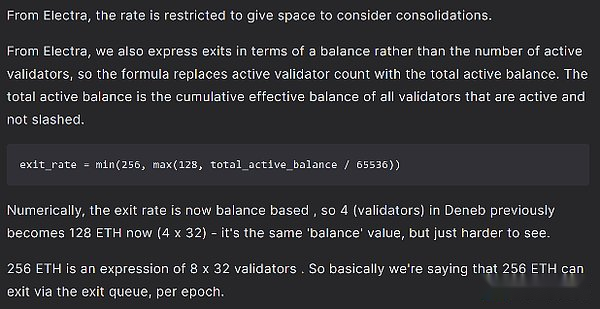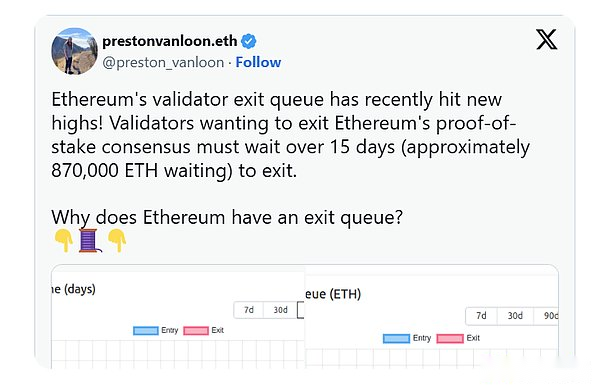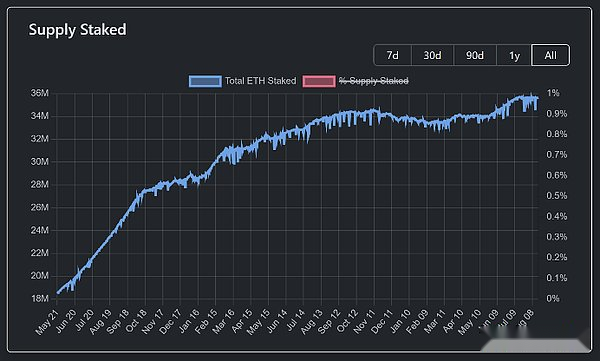
Author: Jack Inabinet, Senior Bankless Analyst; Translation: Bitchain Vision xiaozou
Ethereum staking has long been the ultimate “set-forget” cryptocurrency transaction.Just pledge ETH to ensure network security and enjoy passive benefits!
ETH prices have soared recently, and the crypto-twitter circle is also paying attention to the record waiting time for more than two weeks of pledge withdrawals.But what exactly is the withdrawal queue?How does it work?Why are people suddenly so concerned about this obscure link in the Ethereum architecture?
Let’s find out in this article.
1, What is withdrawal queue (Withdrawal Queue)?
The successful implementation of the Ethereum merger in September 2022 marks the completion of Ethereum’s transformation from Proof of Work (PoW) to Proof of Stake (PoS) – an upgrade that formally handed over control of network security to stakers.
Under the Ethereum PoS mechanism, all stakers must deposit at least 32 ETH as margin to obtain permissions to store network data, process transactions, and add blocks to the chain.Stakers receive ETH rewards by maintaining network security.
ETH staking was originally a one-way/deposit-only commitment mechanism, but the Shapella upgrade in April 2023 allows stakers to withdraw ETH from staking.
To ensure network security and prevent unintended downtime, the Ethereum network enforces a “withdrawal queue” mechanism for all stakeholders who want to extract ETH from the verification node.
2, How does the withdrawal queue work?
The withdrawal queue supports both partial withdrawals (only the accumulated validator rewards are withdrawn and retained in the validator collection) and full withdrawals (withdraw all ETH rewards and pledged ETH and exit the validator collection).
The system processes withdrawal requests using a watch-type polling mechanism, and each block processes up to 16 partial or full withdrawal combinations.The processing order starts from the earliest established validator, gradually processes to the latest established validator, and then recycles.Currently, this mechanism takes about 9 days to complete a complete “scan” of the entire active validator collection.
If the ETH balance held by the account exceeds the node margin, some withdrawal requests will automatically enter the withdrawal queue.However, when making a full withdrawal, the pledger must first go through an additional exit queue review.
Although the exit queue capacity will be dynamically adjusted with the number of active validators, its throughput is much lower than the withdrawal queue itself.The Ethereum Electra upgrade sets the exit queue cap for each epoch (32 blocks) to 256 ETH, which actually limits the full exit requests processed by each epoch to a maximum of 8 full nodes.

3, Why is the withdrawal queue so important?
The impact of queue blockage is much more than just allowing the “independent pledger” to wait a few more days before completing the withdrawal.
Liquid staking ETH is the cornerstone of the Ethereum capital market.These tokens combine passive ETH gains with transferable deposit certificates and have developed into the main fuel source of the DeFi economy and the lifeline of on-chain leverage.
When someone wants to sell liquid staking ETH tokens (such as Lido’s stETH), their orders can be traded through the ETH unstaking process or the spot market.
Although unstake requests can be processed as soon as one day (especially for large staking operators like Lido and Coinbase with a large number of validation nodes scattered in a collection), the waiting time for exiting the queue alone is more than 16 days as the current record number of validators scramble to exit.

In the financial market, time is money.Now pledge withdrawals take more than two weeks to process, and parties (such as market makers) that provide liquidity in liquidity of liquidity of liquidity of staked tokens (LSTs) are beginning to demand greater “discounts”.
Ideally, liquid staking ETH tokens can be converted to the amount of ETH it represents in a ratio of 1:1.However, when the withdrawal queue imposes substantial waiting time on the full exit of the validator, market makers begin to count higher LST holding costs into the quote.
As the exit time is further extended, market makers may begin to demand bigger discounts.
This creates a vicious cycle: the deviation between LST and natural 1:1 anchorage continues to increase, resulting in forced liquidation of LST positions, causing market makers to back up a large amount of LST inventory that needs to be redeemed, and thus causing a longer wait time for exiting the queue.
More importantly, if the ETH perpetual contracts and futures contracts used to hedge the risk of LST inventory price have a spot premium (i.e. negative capital rates), market makers will face higher hedging costs, which will in turn be passed on to the final trader through a larger LST discount!
Despite the recent increase in validator exit requests, the overall situation of Ethereum staking remains balanced.Since mid-July, the pledge inflows have basically offset the withdrawal volume, making the total ETH pledge stable at around 35.5 million.

Unfortunately, this dynamic balance cannot alleviate the impact of extended withdrawal waiting time, because Ethereum’s deposit queue and exit queue are two completely independent mechanisms.
Ethereum bulls quickly refuted their concerns about exiting the queue as “fear, uncertainty and suspicion”. They listed cases of digital asset funds continuing to buy ETH, and talked about historical experiences similar to the strong price performance after the peak.However, longer withdrawal waiting times are not just superficial issues.
This structural bottleneck is based on the original intention of good design, and it has also become a blocking point for the DeFi ecosystem: longer exit times mean more severe LST discounts, higher hedging costs, and may trigger reflective leverage closing risks.







